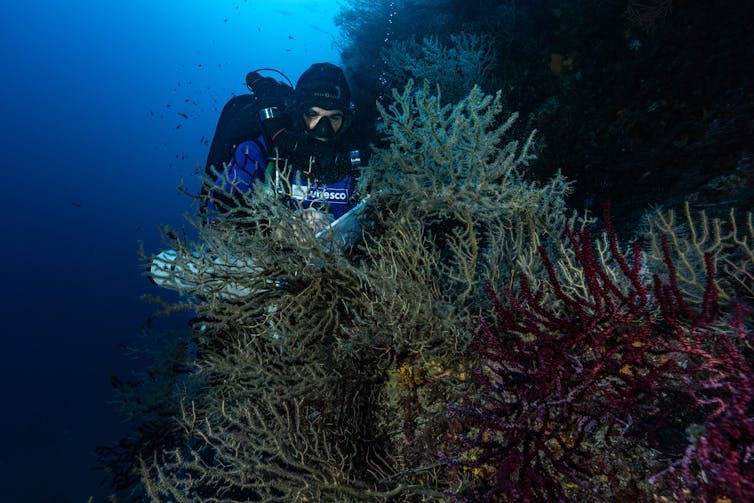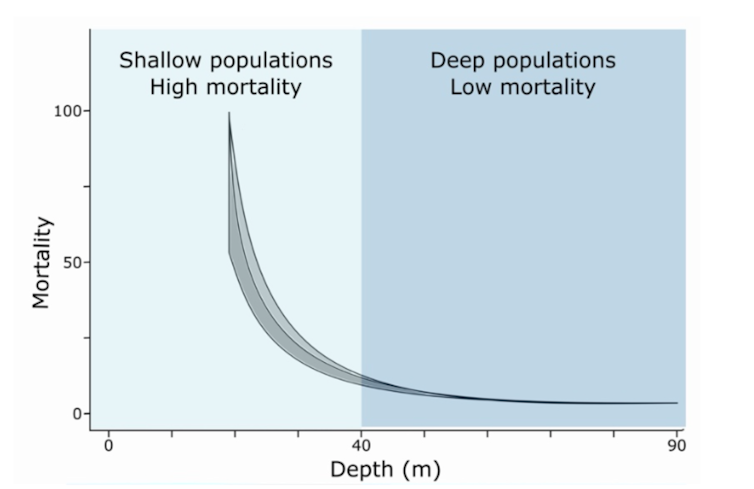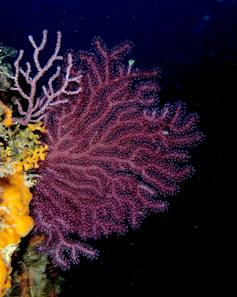Over the last 20 years, the world’s oceans have experienced a significant increase in episodes of high-sea surface temperatures, known as marine heat waves.
These events have become more frequent and intense over time, leading to significant changes in marine ecosystems. High ocean temperatures often lead to massive die-offs among marine organisms.
This phenomenon is particularly pronounced during the summer months in the Mediterranean Sea between July and August. Among the species greatly affected by this environmental disturbance is the red gorgonian, Paramuricea clavata.
Lorenzo Bramanti, Author provided (no reuse)
Corals of major ecological importance due to their role as an engineer species. When populations of red gorgonians reach high densities of large individuals, they create habitats similar to underwater forests that serve as a refuge or hunting ground for many species, thereby enhancing local biodiversity. Their decline can therefore have devastating consequences for the marine ecosystem as a whole.
However, recent research carried out with several colleagues suggests that by finding refuge deeper in the sea, where the temperature does not rise as much, red gorgonians could escape marine heat waves.
Marine heat waves and mortality
Episodes of mass mortality of red sea fans have been reported since the 1980s, but the frequency of documented events intensified from 1999 onwards: 2003, 2006, 2018 and 2022…
Just as fires devastate forests on land, marine heatwaves decimate shallow populations in the Mediterranean, from Spain to France and Italy, as well as in Croatia. The heatwave of summer 2022, one of the most dramatic in the history of the western Mediterranean, was particularly deadly for red sea fans at depths of up to 30 metres.
The severity of these losses – directly linked to heat at the sea surface – seems to depend both on the severity of the temperature rise and the length of time that the high temperatures persist. Two parameters that together make its survival increasingly difficult.

Alexis Rosenfeld/Unesco
Looking for coolness at greater depths
Despite this worrying situation, there is still a glimmer of hope. The red gorgonian has a wide bathymetric range – in other words, the depth range within which the species can survive. If this range is wide, the species will be present both near the surface and at greater depths.
This is the case here, since it is found between 10 and 200 metres: even if the surface populations decline, those at greater depths remain. Conversely, a species found only in the first 30 metres of water would be completely eliminated by mortality linked to the rise in water temperature.
Up until now, readings indicate that during marine heat waves, the temperature decreases the deeper you go. In other words, gorgonian forests can still find refuge in deeper areas to protect themselves from the threats they face at the surface.
Insufficient scientific data
Unfortunately, most of the scientific data on red sea fans mortalities mainly concern shallow populations, located at depths of between 15 and 25 metres, with a few rare cases going beyond 30 metres.
Recently, citizen science programmes – often carried out by recreational scuba divers – have played an essential role in the early detection of these mortality events by providing valuable data. But their observations are generally limited to shallow depths.
Thanks to significant advances in scuba diving technologies, scientists are now able to conduct research at unprecedented depths. The adoption of closed-circuit rebreathers (CCRs), which recycle exhaled air, allows for longer dives, and the use of breathing gas mixtures, known as TRIMIXs, make dives to even greater depths possible.
Thanks to these advances, our group of French (CNRS, Ifremer, Sorbonne and Septentrion Environnement) and Spanish (CSIC) researchers has been able to monitor the health of red gorgonian populations at depths of up to 90 metres in the Mediterranean Sea.
Mortality down at depths of over 40 metres
Analysis of data collected from 14 deep red gorgonian populations between 40 and 90 metres deep, combined with data from 29 shallower populations from a citizen science initiative (T-MedNet database), revealed a significant reduction in mortality below the 40-metre threshold.

Author, Author provided (no reuse)
This discovery suggests that the zone below 40 metres, also known as the mesophotic zone – or twilight zone due to the marked reduction in light penetration – may function as a refuge for the Mediterranean red gorgonian, protecting its populations from the harmful effects of marine heat waves.
These findings confirm the “deep reef refugia” hypothesis, according to which marine populations residing at greater depths are less sensitive to the impacts of climate change, particularly with regard to rising sea surface temperatures.
Temporary refuge
However, our knowledge of populations below 40 metres is still limited, which restricts our ability to predict how marine heat waves will affect them.
The preservation of populations at depth may not last when more frequent and severe marine heat waves affect temperatures at previously unexposed depths. At that point, populations in deeper areas could also have a lower heat tolerance than their shallower counterparts and therefore be more vulnerable.
As a result, this refuge at depth does not definitively protect gorgonians from the effects of climate change. Their survival will depend above all on the extent of connectivity between these populations (in other words, their ability to intermingle) and their reaction to rising water temperatures, parameters that are still poorly understood.
Better understanding for better protection
It is therefore vital to improve our knowledge of the mesophotic zone, the connectivity between deep and shallow populations and the way in which each population adapts to changing environmental conditions, in order to determine how long these refuges will last.
Let’s see this temporary refuge as a gift from the deep sea, offering us an additional period during which the deep populations are sheltered from the effects of global warming. And let’s make the most of this period of respite to understand how these underwater forests function, the mechanisms of resilience, and possibly design restoration interventions.
All this will be of no use, however, if we do not commit to reversing the process of climate change by adopting policies to reduce CO2 emissions.

UNESCO’s duty remains to reaffirm the humanist missions of education, science and culture. Mobilise education to transform lives; Reconcile with the living; Promote inclusion and mutual understanding; Foster science and technology at the service of humanity are UNESCO’s key strategic objectives.




